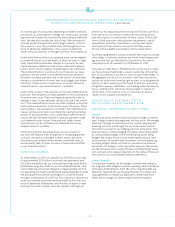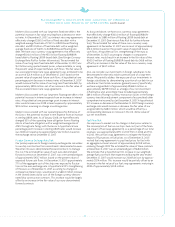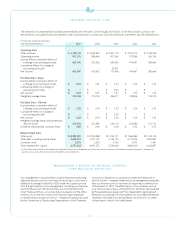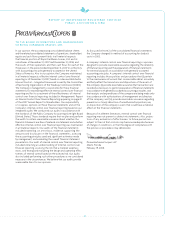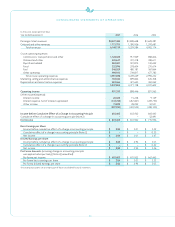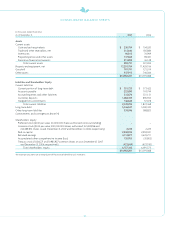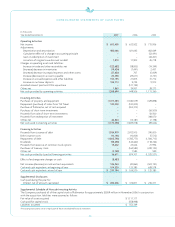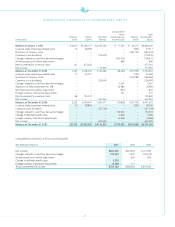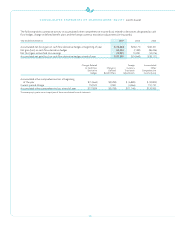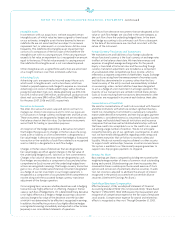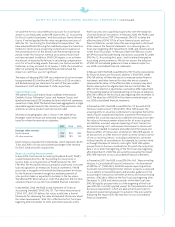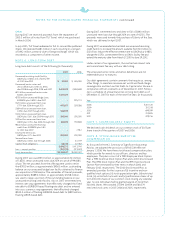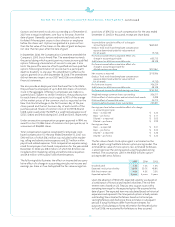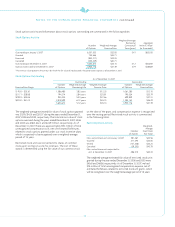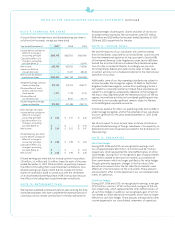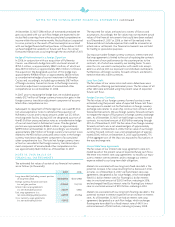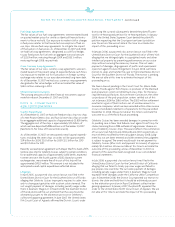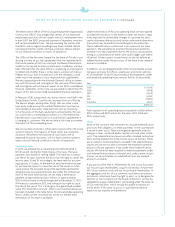Royal Caribbean Cruise Lines 2007 Annual Report Download - page 32
Download and view the complete annual report
Please find page 32 of the 2007 Royal Caribbean Cruise Lines annual report below. You can navigate through the pages in the report by either clicking on the pages listed below, or by using the keyword search tool below to find specific information within the annual report.
Intangible Assets
In connection with our acquisitions, we have acquired certain
intangible assets of which value has been assigned to them based
on our estimates. Intangible assets that are deemed to have an
indefinite life are not amortized, but are subject to an annual
impairment test, or when events or circumstances dictate, more
frequently. The indefinite-life intangible asset impairment test
consists of a comparison of the fair value of the indefinite-life
intangible asset with its carrying amount. If the carrying amount
exceeds its fair value, an impairment loss is recognized in an amount
equal to that excess. If the fair value exceeds its carrying amount,
the indefinite-life intangible asset is not considered impaired.
Other intangible assets assigned finite useful lives are amortized
on a straight-line basis over their estimated useful lives.
Advertising Costs
Advertising costs are expensed as incurred except those costs,
which result in tangible assets, such as brochures, which are
treated as prepaid expenses and charged to expense as consumed.
Advertising costs consist of media advertising as well as brochure,
production and direct mail costs. Media advertising was $153.4 mil-
lion, $141.3 million and $139.1 million, and brochure, production and
direct mail costs were $99.0 million, $89.5 million and $86.9 million
for the years 2007, 2006 and 2005, respectively.
Derivative Instruments
We enter into various forward, swap and option contracts to
manage our interest rate exposure and to limit our exposure
to fluctuations in foreign currency exchange rates and fuel prices.
Theseinstruments aredesignated as hedges and are recorded on
the balance sheet at their fair value. Our derivative instruments
are not held for trading or speculative purposes.
At inception of the hedge relationship, a derivative instrument
thathedges the exposure to changes in the fair value of a recog-
nized asset or liability, or a firm commitment is designated as a
fair value hedge. A derivative instrument that hedges a forecasted
transaction or the variability of cash flows related to a recognized
asset or liability is designated as a cash flow hedge.
Changes in the fair value of derivatives that are designated as
fair value hedges are offset against changes in the fair value of
the underlying hedged assets, liabilities or firm commitments.
Changes in fair value of derivatives that are designated as cash
flow hedges are recorded as a component of accumulated other
comprehensive(loss) income until the underlying hedged trans-
actions are recognized in earnings. The foreign-currency transaction
gain or loss of our nonderivative financial instrument designated
as a hedge of our net investment in our foreign operations is
recognized as a component of accumulated other comprehensive
income along with the associated foreign currency translation
adjustment of the foreign operation.
On an ongoing basis, we assess whether derivatives used in hedging
transactions are“highly effective” in offsetting changes in the fair
value or cash flow of hedged items. If it is determined that a derivative
is not highly effective as a hedge or hedge accounting is discontin-
ued, any change in fair value of the derivative since the last date
at which it was determined to be effective is recognized in earnings.
In addition, the ineffective portion of our highly effective hedges
is recognized in earnings immediately and reported in other income
(expense) in our consolidated statements of operations.
Cash flows from derivative instruments that are designated as fair
value or cash flow hedges are classified in the same category as
the cash flows from the underlying hedged items. In the event
that hedge accounting is discontinued, cash flows subsequent
tothe date of discontinuance are classified consistent with the
nature of the instrument.
Foreign Currency Translations and Transactions
We translate assets and liabilities of our foreign subsidiaries
whose functional currency is the local currency, at exchange rates
in effect at the balance sheet date. We translate revenues and
expenses at weighted-average exchange rates for the period.
Equity is translated at historical rates and the resulting foreign
currency translation adjustments are included as a component
of accumulated other comprehensive (loss) income, which is
reflected as a separate component of shareholders’ equity. Exchange
gains or losses arising from the remeasurement of monetary assets
and liabilities denominated in a currency other than the func-
tional currency of the entity involved are immediately included
in our earnings, unless certain liabilities have been designated
toactas a hedgeof a net investment in a foreign operation. The
majority of our transactions are settled in United States dollars.
Gains or losses resulting from transactions denominated in other
currencies are recognized in income at each balance sheet date.
Concentrations of Credit Risk
We monitor concentrations of credit risk associated with financial
and other institutions with which we conduct significant business.
Credit risk, including but not limited to counterparty nonperfor-
manceunder derivative instruments and new ship progress payment
guarantees, is considered minimal, as we primarily conduct business
with large, well-established financial institutions and insurance
companies that we have well established relationships with and
thathavecredit risks acceptable to us or the credit risk is spread
out among a large number of creditors. We do not anticipate
nonperformance by any of our significant counterparties. In addi-
tion, we have established guidelines regarding credit ratings and
investment maturities that we follow to maintain safety and
liquidity. We do not normally require collateral or other security
to support credit relationships; however, in certain circumstances
this option is available to us. We normally require guarantees to
support new ship progress payments to shipyards.
Earnings Per Share
Basic earnings per share is computed by dividing net income by the
weighted-average number of shares of common stock outstanding
during each period. Diluted earningsper shareincorporates the
incremental shares issuable upon the assumed exercise of stock
options and conversion of potentially dilutive securities. In addi-
tion, net income is adjusted to add back the amount of interest
recognized in the period associated with convertible dilutive
securities. (See Note 9. Earnings Per Share.)
Stock-Based Employee Compensation
Effective January 1, 2006, we adopted Statement of Financial
Accounting Standard(“SFAS”) No. 123 (revised 2004), “Share-Based
Payment,” (“SFAS 123R”). SFAS 123R requires the measurement and
recognition of compensation expense at the fair value of employee
stock awards. Compensation expense for awards and related tax
effects is recognized as they vest. Through December 31, 2005,
30
NOTES TO THE CONSOLIDATED FINANCIAL STATEMENTS continued


